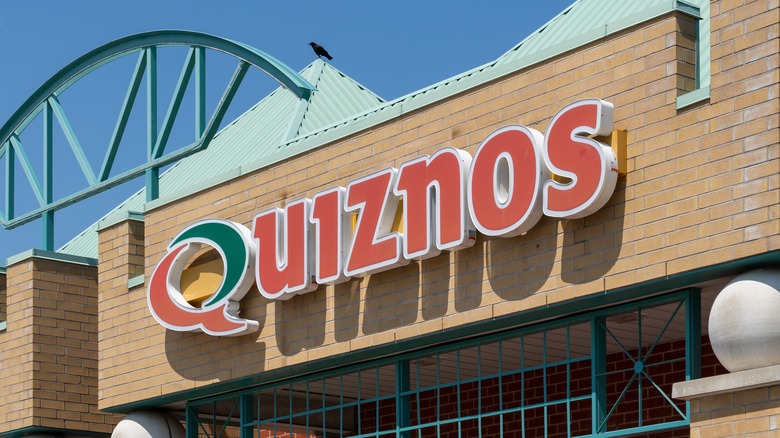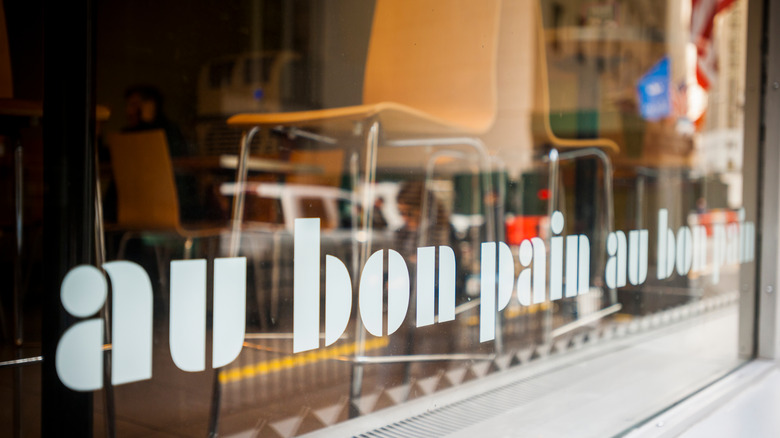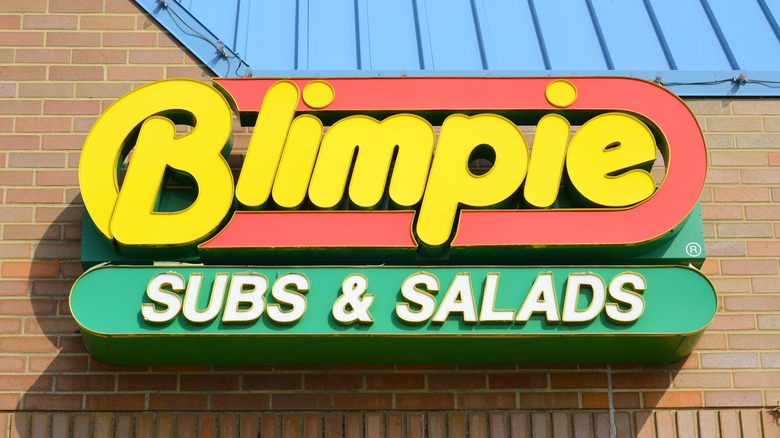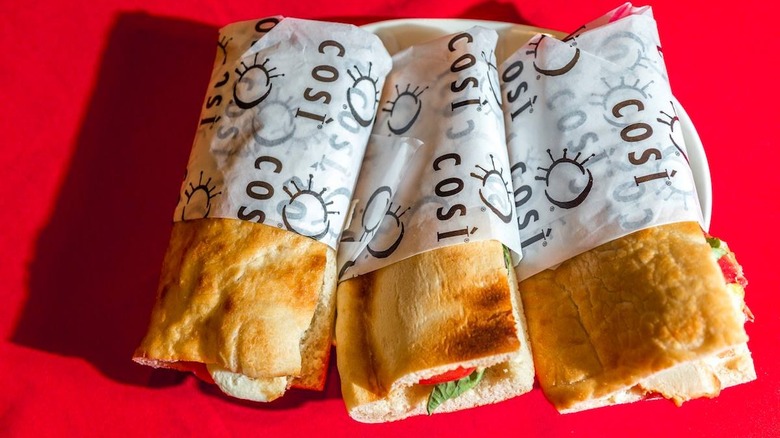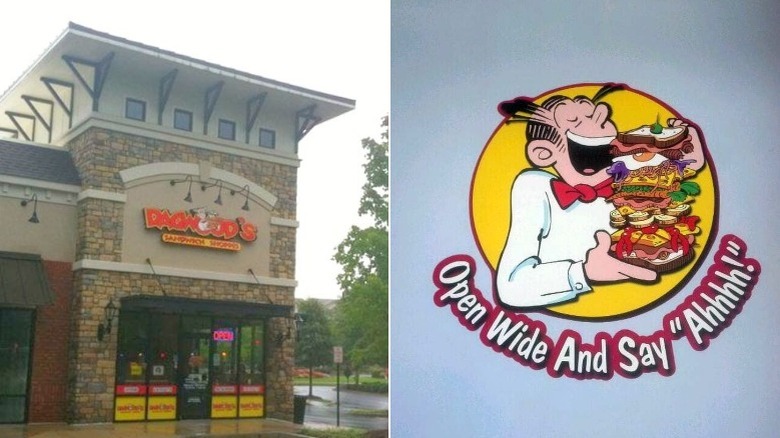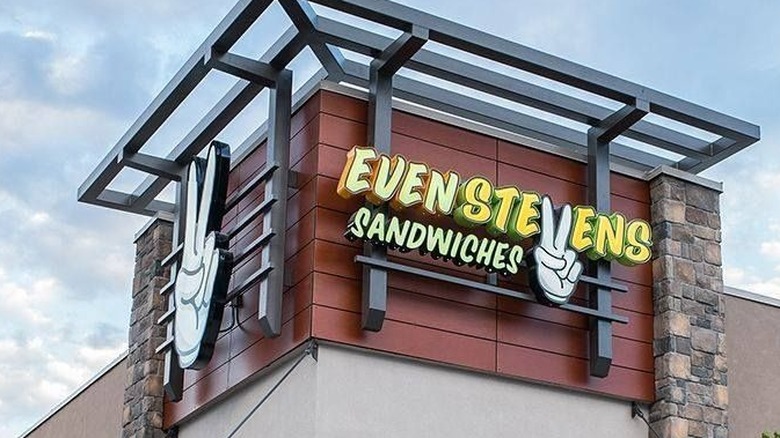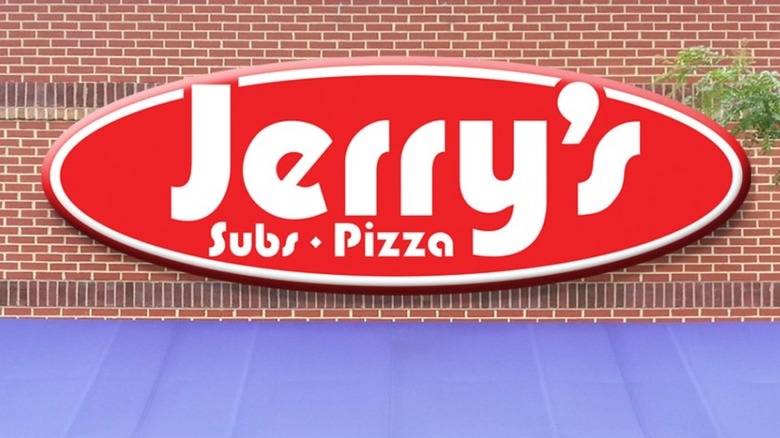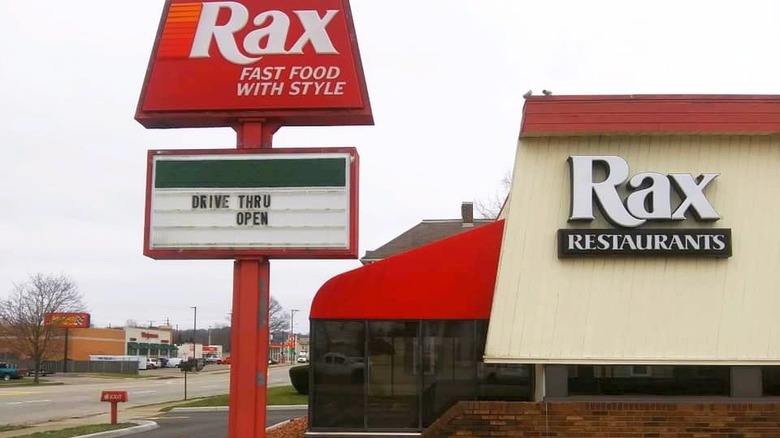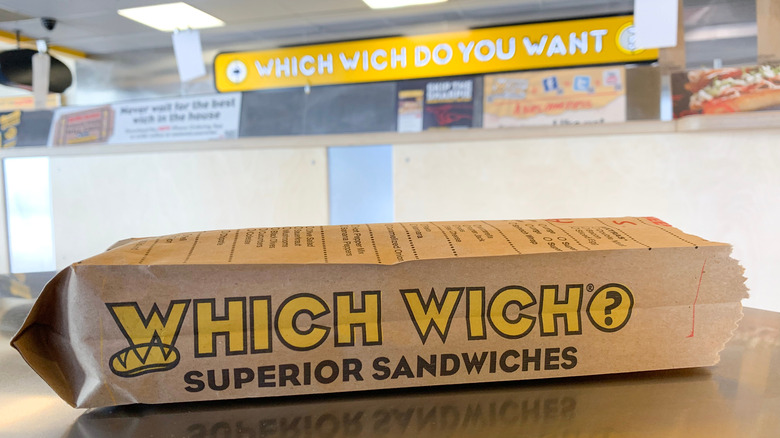9 Chain Sandwich Shops That Are Disappearing In The US
Thanks to John Montagu, the fourth Earl of Sandwich, eaters have been enjoying meats stacked between slices of bread since 1762. Two centuries later, and across the pond, sandwiches were being sold en masse, as an array of sub shops popped up across America. Sandwich chains like Subway remain leaders of the stacks to this day while, for one reason or another, others have sadly fallen by the wayside.
Some of these diminished chains were once beloved nationally, while other regional ones once held a special place in the hearts of regulars. Recessions, pandemics, over-expansion, low profits, and mismanagement are just a handful of the reasons for their downfall. It's time to pay respect to those chain sandwich shops that are disappearing in the United States, or have already disappeared altogether.
Hopefully, these chains can turn their crummy fortunes around, and truly get things cooking again with baked fresh ideas. For others looking to open their own sub shop, let's hope there are lessons to be learned here. As Omar Al-Massalkhi, CEO of Talkin' Tacos told Forbes, his mantra is "Don't be Quiznos."
1. Quiznos
Jimmy Lambatos moved from New York to Colorado, and recalled to Westword in 2023, "people were eating sub sandwiches on hot dog rolls. I figured I could make a better sandwich." In 1981, he renamed his Sandwich World shop to Quiznos, and literally got things rolling by toasting his products with the help of a conveyor belt. After he and his partner had grown the franchise into 18 locations, franchisee Rick Schaden and his father bought the entire chain in 1991. Under Schaden, Quiznos rapidly expanded, peaking at 4,700 locations by 2007, and even became a pop culture darling with its Spongmonkey mascots in an odd TV ad.
Subway was Quiznos main competitor, and when the former started toasting its subs, introduced its $5 foot-long campaign, the latter lost its grip on the marketplace trying to keep pace. Low profits, coupled with the recession spelled further trouble for Quiznos, and by 2010, it had closed 1,500 stores.
Quiznos filed for bankruptcy in 2014, and was acquired by investment firm High Bluff Capital Partners four years later. As of March 2024, Quiznos operates 148 locations in 34 states. Sadly, missing from its roster is the original flagship store, which closed in 2023. On its franchising website, the company is trying to move away from its chapter 11 image, saying, "Today, we're doubling on our legacy of innovation by dialing it up to 11."
2. Au Bon Pain
In 1976, Boston eaters were first introduced to the delicious breads and croissants of Au Bon Pain. Ron Shaich merged the patisserie with his cookie store and, in the early '80s, expanded the menu to include sandwiches, beverages, and soups, as well as the chain's physical footprint. By 1987, there were 45 locations, and eventually the chain numbered over 300, at its height.
The urban-friendly Au Bon Pain set its sights on the suburbs when it acquired The St. Louis Bread Company in 1993. Using the latter's concept of larger settings for customers to linger around in, it created the new fast casual chain Panera. By 1999, to further focus Panera, it sold all of its Au Bon Pain holdings. Ironically enough, Panera acquired Au Bon Pain in 2017. By then, the brand was a shell of its former self, closing many stores, including most within its home state of Massachusetts. Sadly, the flagship Harvard Square location, seen in the 1997 film "Good Will Hunting," did not survive the downsizing. The pandemic didn't help matters, as workers stayed away from downtown areas.
Ampex Brands purchased Au Bon Pain in 2021 with an eye to turn things around. Company President Ericka Garza told Franchise Times in 2022 that growth "hadn't been a focus and it hadn't happened in many, many years." As of 2024, the chain has been reduced to about 40 locations. Most stay true to its urban roots, and are housed within universities, airports, or hospitals.
3. Blimpie
Point Pleasant, New Jersey's famed Mike's Submarines not only gave birth to Jersey Mike's Subs, but also served as the inspiration for another chain — Blimpie. Co-founder Tony Conza replicated the sandwiches made at the Jersey Shore shop, and started selling them in Hoboken, starting in 1964. By the late 1970s, Blimpie began to sell franchises, and in the following decade, there were a few hundred locations selling the popular Blimpie Best sandwich. It still lagged far behind its competitor Subway, though, which had over 1,600 locations by 1987.
During that era, Blimpie's national growth stalled, as Conza focused his attention on his Border Cafe restaurants. He reflected in a 1999 Inc. article about Blimpie's turnaround, saying, "We made a list we called '101 small improvements,' like baking fresh bread in every store, hiring a new ad agency, and redesigning our look. It was the rebirth of Blimpie. We went from 275 stores in 1987 to more than 2,000 locations."
In 2006, Kahala Corp. acquired a majority of Blimpie franchises, and a year later, added all the remaining Northeastern locations owned by a separate company — Metropolitan Blimpie Inc. — into its portfolio. Under its stewardship, Blimpie continued to downsize in locations. By 2009, it was reduced to 1,100 locations, and a little over a decade later, dropped to just 300. Not even the "World's First Blimpie" in Hoboken was spared. As of 2024, Blimpie has 115 franchised locations, with a majority of them still residing in the Garden State.
4. Così
New Zealand expat Drew Harré learned how to make focaccia in Rome, and settled in Paris to bake it. In 1989, he opened a gourmet sandwich shop called Così, which was named after the opera "Così fan Tutte." Americans Shep and Jay Wainwright loved Così's food and concept, and franchised it back across the pond. The first one opened in Manhattan, in 1996, serving sandwiches, flatbread pizzas, and to the delight of those waiting in line, free samples of its focaccia romana. Within two years, Così had 8 New York locations, and then started to branch out beyond the Big Apple.
In 1999, Così merged with Xando Coffee and Bar to create a destination for morning, noon, and night, including an expanded beverage menu, and even desserts like s'mores. By 2006, the company had a stock price high of $43, and two years later, notched its highest location total number at 151. What followed were a revolving door of CEOs, and two rounds of bankruptcy declarations for Così, in 2016 and then again in 2020 when it was down to just 29 locations. In a press release, the company said the path forward included, "shedding of certain legacy costs, further business streamlining and, possibly, select location moves."
Since then, Così has shifted its focus to catering, and even selling bake-at-home flatbread kits. According to Così's app, as of 2024, it has 9 brick-and-mortar stores, mainly situated on the East Coast, and one in Chicago.
5. Dagwood's Sandwich Shoppe
In 1973, Dean Young took over the "Blondie" comic strip from his father Chic Young. Blondie's husband Dagwood adored piled-high sandwiches, and in 2006 Dean opened a sub shop in Palm Harbor, Florida to honor that. At Dagwood's Sandwich Shoppe, the comic's artwork was used for décor, and one could even order up a namesake double-decker sandwich, consisting of 24 ingredients, and weighing in at 11½ pounds.
Young and his business partner Lamar Berry had an eye on opening 50 locations within a year, and 600-800 within five. Berry told the Springfield Business Journal in 2007, "Dagwood's is going to be a formidable force," Berry said. "We're pretty comfortable saying that now because of the early demand [for] and success of our market partner territories." They went on to sell the franchise to 27 territories, which was worth 1,354 units. Within two years, 19 actual locations had opened across the states of Louisiana, Missouri, Alabama, Kentucky, Georgia, Texas, Indiana, and South Carolina, with the promise of more to come.
By the end 0f 2007, the rising sandwich chain was quickly going down the drain. Profitability was an issue, and the company closed its corporate office by the end of that year, leaving franchisees out in the cold. A pair of them sued the corporation for, "repeated, intentional and naked fraud of a franchisor, Dagwood's Sandwich Shoppe." (via Franchise Times). A majority of locations quickly closed thereafter, although one in Springfield, Missouri hung on until 2015.
6. Even Stevens Sandwiches
Steve Down had a noble idea for a sandwich chain — for every sandwich it sold, the shop would donate one to a charity. That's where the name Even Stevens Sandwiches came from, and in 2014, the first one opened in Salt Lake City, Utah. The store's philosophy was "eat-to-give," and customers came in to order fun named sandwiches like Do Gouda and Sprang Chicken. More locations sprung up in Utah, as well as in neighboring states. Even Stevens donated to over 80 charities in six states, and earned several accolades for its good work, including winning the Restaurant Neighbor Award twice from the Utah Restaurant Association.
Even Stevens topped out at 20 locations, but signs of decline started when it suspended its donations program in 2018, with the counter on its website frozen at 3,878,706 sandwiches. While the move was seen as a temporary one, stores were losing $800,000 a month, and it shuttered 5 locations in Arizona that same year. Even Stevens declared bankruptcy in 2019, and shuttered stores in Texas, Colorado, and more in Arizona. After declaring bankruptcy, Chief Restructuring Officer Brooks Pickering said to KSL, "As a start-up, Even Stevens came out of the gate with positive momentum but expanded too quickly, saddling the company with significant financial and operational challenges." Locations in Utah, and one in Boise, Idaho hung around, but all were closed by 2023, with many facing eviction notices for unpaid rent and even food safety inspection failures.
7. Jerry's Subs and Pizza
Abe and Leiah Suls gave up on their coffee shop and instead opened a sandwich shop named after their son Jerry, in Wheaton, Maryland, in 1954. In 1979, Dave Terzian and partners turned the restuantant into a franchise with its Jerry's Systems company. By 1990, Jerry's Subs and Pizza had over 60 locations, and set up shop in states such as Florida, Wisconsin, Georgia, and even a co-branded location on Long Island, New York, alongside Dunkin' Donuts and Baskin Robbins. The chain was name dropped by infamous Watergate mastermind G. Gordon Liddy, and even drew the attention, and ire of the Clinton White House.
By 2002, Jerry's Subs and Pizza concentrated growth in its home area of Maryland and Virginia, and had 130 shops in operation. Growth had stalled in the following decade, with Jerry's President and CEO Eli Chediak telling the Washington Post in 2015, "We've made dramatic changes to Jerry's menu, introduced new products and launched a new marketing strategy as part of an ongoing effort to rescue this iconic Washington brand. A lot has changed since 1954, and over time, Jerry's had fallen victim to a variety of market forces and economic trends."
The trends and forces didn't seem to improve, as Jerry's Subs and Pizzas fell even further. As of July 2024, the chain has been reduced to only 3 locations, all in Maryland.
8. Rax
Jack Roschman took time out from developing Burger Chef franchises in Ohio, to start his own roast beef sandwich restaurant in 1967 called Jax. Business was good enough within a year that it was bought by General Foods. The company opened more locations, and in 1969, renamed the chain RIX Roast Beef. By 1977, the chain had 100 locations, and its new owners, RAC Roast Beef of Columbus, combined the two previous names to form its final and current moniker — Rax.
In the 1980s, Rax had racked up over 500 locations across 38 states, and abroad. By the early 90s, the chain was losing money, and started to close multiple stores. It even tried a marketing Hail Mary by introducing the wise-cracking mascot Mr. Delicious. Mr. D tried to position the chain as an "adult fast food place." Not long after, Rax filed for bankruptcy protection.
Former Rax employee Rich Donohue stepped in to try and revive the franchise, starting in 2008. Donahue told The Daily Independent in 2022, "A lot of people say Mr. Delicious is what killed Rax, but there were already problems there," adding, "Corporate was cutting into the quality." Rax currently has 8 locations, with 6 in Ohio, and one each in Kentucky and Illinois respectively.
9. Which Wich Superior Sandwiches
After parting ways with his Mongolian barbecue chain Genghis Grill, Jeff Sinelli next turned his attention to sandwiches. As Chief Vibe Officer, Sinelli launched Which Wich Superior Sandwiches in 2003, which immediately stood out in the sub shop landscape with its bright yellow decor. With over 60 ingredients to choose from, customers' hands were busy with a sharpie, checking off boxes on the bag, in which orders were placed. By 2005, Which Wich began franchising, and five years later, opened its 100th store. At its highest point, Which Wich had 450 locations in 39 states and 11 countries.
While most other chains adapted to new technologies in the 2010s and '20s, Sinelli admitted to QSR that "we're really an analog concept in the digital world." At the start of the Pandemic in 2020, and through 2023, Which Wich closed over 130 locations, to bring its domestic total to around 220. Despite the brief downturn, Sinelli still feels there are major markets up and down the East Coast ready for a Which Wich. He added, "we want to focus on our sandwiches and being better and faster so we can sell more of them in more and more places."

